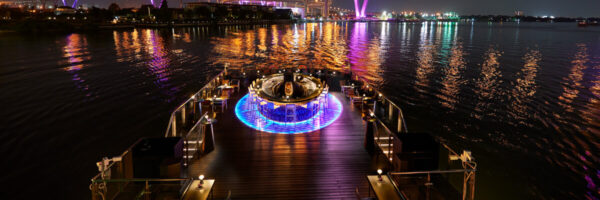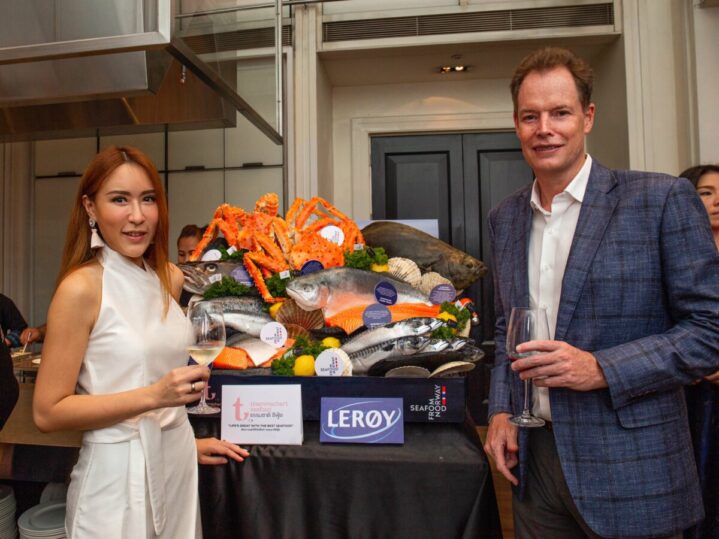
The creation of Thammachart Seafood
When I was a kid, my Dad used to offer me $5 to eat one clam; I refused. I am not a seafood lover, but after sitting down and talking with Julian and Yeeran Davies, CEO and CMO of Thammachart Seafood, the tide has started to turn for me. Thammachart Seafood, meaning ‘natural’ in Thai, has been changing people’s perspectives on seafood for nearly 15 years. The story of Thammachart and how they have revolutionised one of Thailand’s largest industries with the simple aim of bringing responsibly sourced, better quality seafood, not only to their own family’s dinner table, but to the tables of everyone in Thailand, is quite inspiring. As Yeeran said, “whatever we serve to our customers, we give to our own family.” Originally from Kenya but educated in the UK, Julian came to Thailand around 25 years ago as part of a PhD programme in biotechnology and aquaculture. He was based in the east of Thailand and had planned to collect data and do research on a shrimp farm for several months as part of his studies. Rather than finishing his PhD, he ended up taking a job as operations manager for the company he was doing research for. After several years at the company, there was a management buyout and Julian took over the company as the managing director. Yeeran entered the scene around the same time as an experienced and visionary marketing manager.

Yeeran grew up with 4 older brothers and her family had a successful textile business so it’s no surprise that she was instrumental in cultivating the family business atmosphere of Thammachart. She spent some time studying in Minnesota in the US and completed her studies at Chulalongkorn University in Communication Arts. She was working in advertising when she saw an ad for a shrimp farm looking for a marketing manager. It was attractive to her because she saw a chance to branch out from her own family business and use what she had learned to create her own path. She also liked the idea of working with a company that focused on the full lifecycle of the product. The melding of Julian and Yeeran’s unique skill-sets led not only to the establishment of Thammachart but also to a marriage and two effervescent children. This family approach to the business is something that makes the company special in the industry. Julian and Yeeran have built the company while raising two lovely children. They personally visit many of their suppliers in Norway, Australia, New Zealand, Europe and across Asia and when possible take the children with them to the farms and fisheries and have great family fun on the trips. They also aim to treat their nearly 900 employees like family; I certainly saw lots of smiles in the short time I spent in the office.
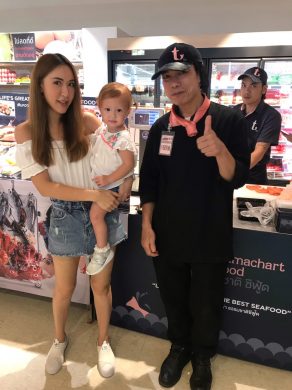
For those unfamiliar with the normal operations of the seafood industry, as I was, here’s basically how it works (or in the case of business who now partner with Thammachart, worked). I’ll use shrimp as an example because Thailand is a massive producer of shrimp (in fact, 90% of Thai shrimp are for export) and shrimp farms are the origin of Thammachart. Farmers grow shrimp over the course of 4-6 months. Weather can majorly affect their harvests and lead to crop failures and disease. In the past, there was widespread unregulated use of antibiotics and chemicals which has put a bit of a black mark on the industry. Luckily, this has been massively regulated for the last 15 years, both domestically and internationally so it’s shouldn’t be a concern for consumers. After farmers harvest the shrimp, they sell them to the highest bidder. Brokers then warehouse the shrimp for a day. The shrimp sit in water overnight and absorb it, adding to their weight. After a day, they are distributed to grocery stores and other buyers who sell them to consumers. Voila, 2-3 day old shrimp cocktail. Mmmmm….
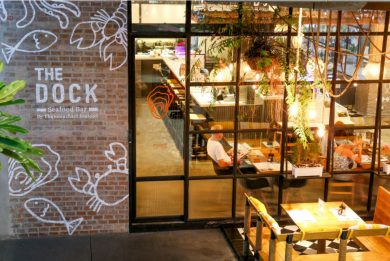
When Thammachart came on the scene, they threw a wrench in these finely oiled shrimp industry gears. Julian and Yeeran wanted to create a solution to bring the consumer and the source as close together as possible. Waterlogged, 3 day old shrimp did not seem like the best possible solution to them but it was how everyone was operating because there was no other option. Grocery stores, restaurants and especially consumers couldn’t possibly outbid the massive seafood brokers. Since Thammachart already owned shrimp farms, they were able to build out a ‘farm to table’ solution and present it as a viable business alternative to a major grocer at the time: Carrefour. Thammachart’s successful partnership with Carrefour made it possible for the grocer to buy fresher seafood at a lower price. It was a win-win for everyone – including the environment because Thammachart runs a tight ship in terms of how and where they farm their shrimp. They have been used as an example for the Department of Fisheries as a sustainable, clean seafood model and are audited weekly for antibiotic and chemical usage. The overwhelming Carrefour success got Thammachart noticed by The Mall Group in 2005. They were asked to take over the seafood counter at Emporium. Consumers noticed the difference in quality and presentation but weren’t lightening their wallets any less.

This turn-key solution to seafood counter management led to the formation of Thammachart Seafood Retail in 2007. They had 4 counters to start. Now, they manage 195 counters in leading supermarkets all over Thailand. The quality of the product speaks for itself but Yeeran used her marketing savvy to develop the brand so that consumers know that if they are buying from a Thammachart staffed and run concession, they are getting good quality. Shrimp is obviously still one of the product lines, but 40% of their turnover is from salmon and trout. In fact, they import the largest volume of these two fish to Thailand which means they have the volume to have the best quality possible. Despite the enormous variety of seafood, most people stick to what they know. When I asked Julian why people aren’t more adventurous when it comes to seafood, he explained that there is a “fear of the unknown”. For this reason, Thammachart makes sure to serve all the ‘fan favourites’ but they also make an effort to always stock some of the more obscure options so that people have the opportunity to learn about and try more seafood.
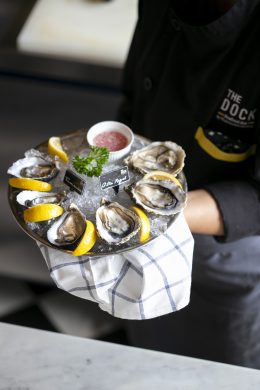
Thammachart works with 6-8 origins around the world for their imports and doesn’t work with consolidators because they don’t want their product to sit for a day or more. They get as close as possible to the suppliers and actually visit them so they can see exactly who they are dealing with. Controlling the quality of what they offer is very important to them. To get the more unknown seafood while keeping the price reasonable, they will tack small shipments of monkfish, for example, on to a one of their regular large shipments of say, oysters from France or salmon from Norway so that they can get the freshest fish without paying for a special shipment. This strategy allows them to bring smaller volume items direct to the consumer without an astronomical price tag. Julian and Yeeran have also added restaurant outlets to Thammachart’s structure and at three different levels. They first established The Dock at Siam Paragon which proved a rapid success so they opened branches in-house at The Mall Group’s Emporium, EmQuartier, Bluport Hua Hin, Bangkae and a stand alone restaurant in Thong Lor. This is an upmarket fish restaurant concept serving a wide variety of quality dishes to tempt the palate and to expand your horizons. Next came Lobster Lab with the same high quality and varied menu but in a less formal restaurant setting. The latest addition is Seafood Mahanakorn which offers contemporary dishes based on Thai street food with fusions from around the world.

What do Julian and Yeeran see as the future for Thammachart? They are constantly innovating and know that consumers want to have fresh options to pick up and go. The future is convenience and quality for the right price. They have an innovation kitchen in Thong Lor where they are constantly trying new things to better serve the changing market. They also believe that the convenience and price of ready-to-eat meals will turn more non-believers (like me) on to fresh seafood. They also plan to continue developing their offers for online shopping. Their e commerce platform is designed to be an online fishmonger that can tailor make orders, just like in a physical store. The customer can select the fish and preparation style (skin on/off, headless, fillet etc.). Then the fresh fish will be delivered directly to your home. This customer centric approach is what continues to drive Thammachart forward. They strive to make life for the customer as easy as possible and what’s easier than having fresh fish delivered right to your door? For all of us living in Thailand, a country whose cuisine is so heavily seafood based, we have a fantastic opportunity to sample the bounty of the ocean. Thammachart gives us all a safe clean and, most importantly, healthy, delicious option for seafood. I challenge everyone, including myself, to check out a counter and try something new at your dinner table.
Check out their website, www.thammachartseafood.com, for an education on seafood. You can order it delivered direct from the company or even cooked to order through the restaurant delivery companies.



